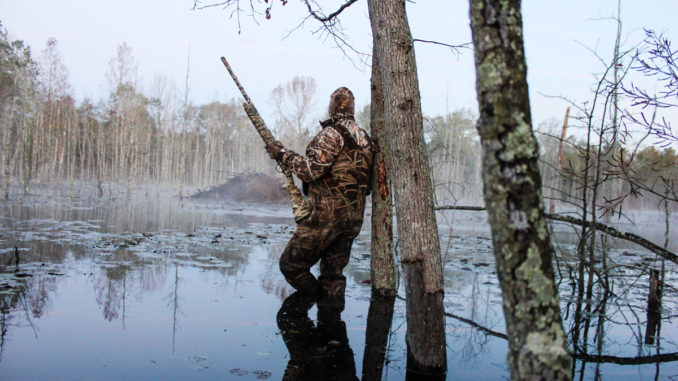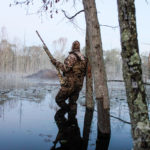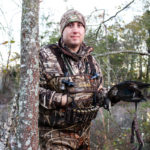
Wood ducks, teal are common targets for North Carolina hunters during short, October duck season.
If an outdoorsman is driven by his passion, then a duck hunters would be a Ferrari. Brimming with a childlike zeal for his quarry, you can rest assured that Oct. 5-8 is circled on his calendar with a big, red heart to show how he feels about the first statewide opportunity to hunt ducks that haven’t dodged steel in North Carolina in more than eight months.
Although there are some hunters whose favorite flavor of waterfowl won’t arrive until bitter cold pushes them south, those targeting wood ducks will have prime opportunities across the state to hunt resident birds as well as early arrivals.
“I hear some people say that they don’t see as many ducks during the early season, but we actually do,” said Lanny Freeman of Stedman, who targets wood ducks with his father, Ernie, nearly every day of the season. “We usually do pretty well, because they stay in the general area. Where I live, they fly over my house all summer. There are a lot that are resident birds.”
In addition to the local birds, numbers add up quickly when the out-of-towners show up. Less tolerant of extreme cold and more likely to migrate with the shortening of daylight hours, woodies are among the first to the party.
“Wood ducks in general migrate a little bit earlier, like teal,” Freeman said. “They come down real early. They migrate more by the time of year. When it gets around that first week of October, they’re starting to come down, regardless. A lot of the diving ducks at the coast — bluebills, canvasbacks — they’re very hardy birds; they’ve literally got to close the water (up north) to run them out of there.”
Adding to wood duck appeal is their availability. Their numbers make up the highest harvest totals among species that visit North Carolina, up to nearly 50 percent some years. Virtually any wet, wooded area, ranging from beaver ponds on private land to a full roster of impoundments spread across the state and managed by the N.C. Wildlife Resource Commission. Swamps, mountain bogs, small farm ponds, streams and backwater sloughs and oxbows of large rivers and reservoirs are all subject to be frequented by wood ducks.
That list of options explains why the Freemans call the wood duck the “working man’s duck.” Chances are, there’s a place close to home where a hunter can slip in, bag his limit, and still make it to the office — as was illustrated in one of their hunts last season.
In the predawn pitch, they pulled off the highway and crept along the edge of a field that gave access to a flooded forest dotted with beaver huts that had grown from a small creek to nearly 50 yards wide. Emerging wader-clad with all of their necessities at hand, they trudged through thick brush and swampy terrain, taking care not to submerge their bibs in a hidden hole.
Settling off the end of a peninsula that jutted into the water, they stood motionless against trees to break up their outline, masked assassins awaiting their signal. Wood duck whistles and trills were audible, along with wing flaps cutting the cool air long before legal shooting time — 30 minutes before sunrise. However, as first light approached, Ernie Freeman fired on the first duck of the morning, sending a woodie spiraling to a splashdown among the flooded trees.
Both Freemans favor 12-gauge shotguns, leaning towards Benelli Super Black Eagles, and their shells of choice are custom made by Federal.
“It’s called Ultra Shok,” Ernie Freeman said. “I really like that shell. In the early season, I like to shoot No. 3s in a 3- or 3 ½-inch shell.”
“The 31/2-inch shell is a bigger boom and a little bit more kick,” Lanny Freeman said, “but once you get used to it, it’s not that big of a deal, and I want all the pellets I can get. The way wood ducks whip in and out, they’re not easy to hit. They’re pretty agile, and it’s not a big duck.”
Lanny Freeman soon showed the value of those extra pellets as he unloaded on a small flock of birds zipping by at about 40 yards, taking the day’s second duck.
“Whether it’s October or November, that first time you go in there, they’ll usually be flying nice and low,” he said. “It’s the same thing with new birds that aren’t familiar with the area. Once you bust them a few times, they’re going to get wary really quick.”
“Some of them you’ll never see again; some of them will change their flight pattern. They’ll move over a couple hundred yards (to) where they’re not flying over the kill zone. Or, they’ll fly their usual route, but they’ll be 150 yards in the air, where you can’t mess with them.”
The Freemans break the wood duck’s learning curve by never hunting the same spot on consecutive days, giving at least a week’s time between areas when longer seasons allow.
Their method of hunting wood ducks, known as “pass-shooting,” is probably the most widely used. Through the scouting process, roosts are discovered, along with likely feeding areas and the route to and from. Hunters then position themselves between the two.
“Wood ducks like to roost where it’s real thick,” Lanny Freeman said. “They don’t like real open water. It would be a hidden spot where there’s a lot of brush and grass, dead trees and thick limbs.
“They’ll fly to somewhere a little more open with a food source like acorns, duck weed, smartweed or seeds like millet. They will get out and walk around and eat the acorns, but generally, they stay in the water, and they’ll fly over water most of the time, following the path of it.”
Within minutes of taking his first bird, Lanny Freeman downed two more ducks from separate pods and declared his limit to have been reached. Resting his shotgun, he began to retrieve those ducks that he could reach on foot.
Patiently waiting for one last group, Ernie Freeman stood his ground and was rewarded with a small flock that passed just into range. He picked one out, shouldered his Benelli, and the report rendered one more woodie cartwheeling into the swamp.
Then, as quickly as it started, it was over. A fast and furious 15 to 20 minutes. According to the Freeman’s, wood ducks make a fast move at first light and stay put until they return to the roost in the evening.
“It’s extremely difficult to shoot them legally in the evening,” Lanny Freeman said. “You’ve got to stop at sunset and it’s usually 30 to 40 minutes after sunset when you see them. If it’s raining or real cloudy, they’ll fly a little earlier than they usually would, but it’s hard to do.”
“Jump-shooting” is technique popular among mid-day hunters, which entails walking or kayaking a meandering creek or swamp and shooting woodies as they flush from their feeding grounds. This strategy is also effective on creeks feeding major rivers and reservoirs, however, care should be taken not to shoot ducks that will need to be retrieved from private property. Also, if one is attempting to jump-shoot the same area he is pass-shooting, he should be careful not to bust roosts or feeding areas that his pass-shooting birds are using, causing them to relocate.
Synonymous with waterfowling is a bag full of decoys and a lanyard heavy with duck calls, but the Freeman’s generally travel light.
“We typically don’t do a lot of calling,” Ernie Freeman said. “We might hit our wood duck call once, but not much, and we don’t put out a lot of decoys. Sometimes we’ll carry a spinning wing decoy, but usually by the time you see them, it’s time to get it on. You can shoot now or forget it.”






Be the first to comment